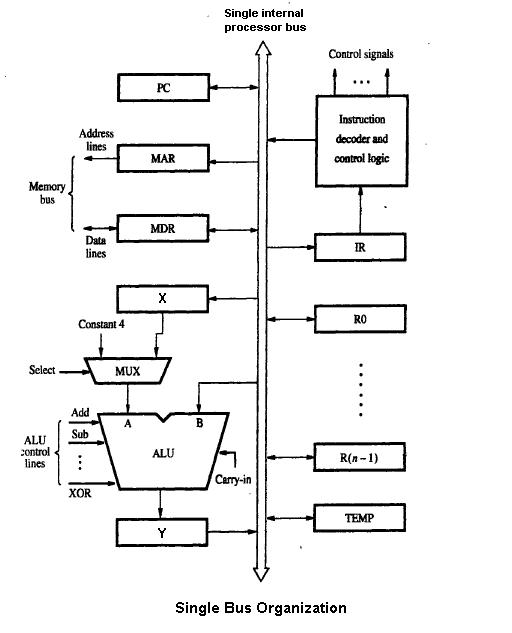Datapath on:
[Wikipedia]
[Google]
[Amazon]
A data path is a collection of functional units such as  The simplest design for a CPU uses one common internal bus.
Efficient addition requires a slightly more complicated three-internal-bus structure.
Many relatively simple CPUs have a 2-read, 1-write register file
connected to the 2 inputs and 1 output of the ALU.
During the late 1990s, there was growing research in the area of reconfigurable data paths—data paths that may be re-purposed at run-time using programmable fabric—as such designs may allow for more efficient processing as well as substantial power savings.
The simplest design for a CPU uses one common internal bus.
Efficient addition requires a slightly more complicated three-internal-bus structure.
Many relatively simple CPUs have a 2-read, 1-write register file
connected to the 2 inputs and 1 output of the ALU.
During the late 1990s, there was growing research in the area of reconfigurable data paths—data paths that may be re-purposed at run-time using programmable fabric—as such designs may allow for more efficient processing as well as substantial power savings.
arithmetic logic unit
In computing, an arithmetic logic unit (ALU) is a Combinational logic, combinational digital circuit that performs arithmetic and bitwise operations on integer binary numbers. This is in contrast to a floating-point unit (FPU), which operates on ...
s (ALUs) or multipliers that perform data processing operations, registers, and buses. Along with the control unit
The control unit (CU) is a component of a computer's central processing unit (CPU) that directs the operation of the processor. A CU typically uses a binary decoder to convert coded instructions into timing and control signals that direct the op ...
it composes the central processing unit
A central processing unit (CPU), also called a central processor, main processor, or just processor, is the primary Processor (computing), processor in a given computer. Its electronic circuitry executes Instruction (computing), instructions ...
(CPU). A larger data path can be made by joining more than one data paths using multiplexers.
A data path is the ALU, the set of registers, and the CPU's internal bus(es) that allow data to flow between them.
 The simplest design for a CPU uses one common internal bus.
Efficient addition requires a slightly more complicated three-internal-bus structure.
Many relatively simple CPUs have a 2-read, 1-write register file
connected to the 2 inputs and 1 output of the ALU.
During the late 1990s, there was growing research in the area of reconfigurable data paths—data paths that may be re-purposed at run-time using programmable fabric—as such designs may allow for more efficient processing as well as substantial power savings.
The simplest design for a CPU uses one common internal bus.
Efficient addition requires a slightly more complicated three-internal-bus structure.
Many relatively simple CPUs have a 2-read, 1-write register file
connected to the 2 inputs and 1 output of the ALU.
During the late 1990s, there was growing research in the area of reconfigurable data paths—data paths that may be re-purposed at run-time using programmable fabric—as such designs may allow for more efficient processing as well as substantial power savings.
Finite-state machine with data path
A finite-state machine with data path (FSMD) is a mathematical abstraction which combines afinite-state machine
A finite-state machine (FSM) or finite-state automaton (FSA, plural: ''automata''), finite automaton, or simply a state machine, is a mathematical model of computation. It is an abstract machine that can be in exactly one of a finite number o ...
, which controls the program flow
In computer science, control flow (or flow of control) is the order in which individual Statement (computer science), statements, Instruction (computer science), instructions or function calls of an imperative programming, imperative computer pro ...
, with a data path. It can be used to design digital logic or computer program
A computer program is a sequence or set of instructions in a programming language for a computer to Execution (computing), execute. It is one component of software, which also includes software documentation, documentation and other intangibl ...
s.
FSMDs are essentially sequential programs in which statements have been scheduled into states, thus resulting in more complex state diagrams. Here, a program is converted into a complex state diagram in which states and arcs may include arithmetic expressions, and those expressions may use external inputs and outputs as well as variables. The FSMD level of abstraction is often referred to as the register-transfer level
In digital circuit design, register-transfer level (RTL) is a design abstraction which models a synchronous digital circuit in terms of the flow of digital signals (data) between hardware registers, and the logical operations performed on th ...
.
FSMs do not use variables or arithmetic operations/conditions, thus FSMDs are more powerful than FSMs. An FSMD is equivalent to a Turing machine
A Turing machine is a mathematical model of computation describing an abstract machine that manipulates symbols on a strip of tape according to a table of rules. Despite the model's simplicity, it is capable of implementing any computer algori ...
in expressiveness.
References
Central processing unit Digital electronics {{CPU technologies